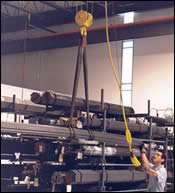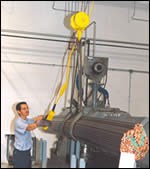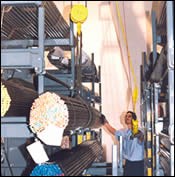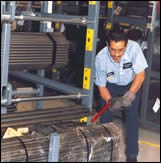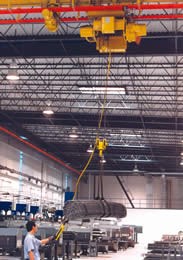Bar Handling Made Easy
DuPage Machine Products, Inc., Bloomingdale, Illinois, puts the TV strongmen to shame every day by moving thousands of pounds of steel thousands of feet—without breaking a sweat. He has a readily accessible material storage system and a crane system that enables him to deliver bundles of barstock from storage to any production screw machine in the shop.
You’ve probably seen competions on TV in which muscle-bound hulks vie for “World’s Strongest Man” or some such title, lifting objects weighing hundreds of pounds and moving them dozens or even hundreds of feet, all the while sweating and straining. You wouldn’t know it to look at him, but Walter Martinez, a materials handler at DuPage Machine Products, Inc., Bloomingdale, Illinois, and the man shown in the accompanying photos, puts the TV strongmen to shame every day by moving thousands of pounds of steel thousands of feet—without breaking a sweat. How does he do it? It’s mostly a result of the tools he has been given to accomplish the task. Specifically, he has a readily accessible material storage system and a crane system that enables him to deliver bundles of barstock from storage to any production screw machine in the shop.
When a truck carrying bundles of barstock arrives at DuPage Machine Products’ new 115,000-square-foot facility, Mr. Martinez unloads the bar using a monorail-mounted crane and moves it to a bar storage area located at the head of one of the plant’s three main aisles. The storage area has four identical Model 4T-2G-24x15R-12 SpaceSaver storage racks made by Steel Storage Systems (Commerce City, Colorado). The model code means that each storage rack is 4 levels Tall, has 2 vertical supports (called Grids), has 24-inch-wide by 15-inch high drawers (Receptacles) and can store 12-foot-long bar lengths. The unit is just under 10 feet tall. Models are available up to eight levels high, with several receptacle sizes.
Featured Content
There are four receptacles each on opposite sides of the storage rack—eight in all. Each has a storage capacity of 5,600 pounds of bar stock. Another 20,000 pounds of material can be stored on top of the storage rack, for a total capacity of 64,800 pounds.
An important advantage of the SpaceSaver over other storage racks is that each receptacle can be moved out (similar to opening a drawer in a dresser) by slipping a crank on the appropriate drive lug and turning it. The receptacle rolls out to the fully open position with eight to 14 turns of the crank, depending on its width. That means that barstock can be loaded in or removed from any given receptacle using an overhead crane without having to disturb any other receptacle. A receptacle can be opened, a bundle can be loaded or unloaded, and the receptacle can be closed again in a matter of minutes.
Dave Knuepfer, president of DuPage Machine Products and a past president of the Precision Machined Products Association (PMPA), sees that as a huge advantage. “Most plants have stackable bar storage racks that can be stacked three or four high,” he explains. “Problem is, the bar that is needed for any given job is invariably in the bottom rack. That means removing the material from the top rack, removing the rack components, doing the same with the next level down and so on until you get down to the material you need. It can take more than an hour to reach barstock in the bottom rack and then put everything back.
“Also, from time to time a bundle of bars can become wedged in a stacking rack,” he continues. “One of the rack components that cradle the bundle may come up with the bundle and then fall off, chipping the floor or, worse, injuring a worker. That doesn’t happen with our new storage racks.”
Very Dense
At DuPage Machine Products, the four Space-Saver racks are arranged in two rows. Because there is no need to provide access to the racks for, say, a cart or forklift, the rows can be tightly spaced. Space between the storage racks in the same row is also minimal. That makes for very dense storage of material that is at the same time very accessible.
Most precision machining plants view bar storage as a necessary evil and begrudge the amount of floor space it takes up. “We’re not in the business of storing material,” Mr. Knuepfer stresses. “We’re just storing material temporarily—a few days at most. If we have more than a few days of material on our floor, we’re not doing a very good job of purchasing our material. Generally, any material that comes in on a given day will be used that day or the next.”
DMP’s four storage racks take up about 640 square feet, or about 0.5 percent of the plant’s total floor space. According to Mark Devine, materials manager for DMP, the amount of floor space given over to bar storage at the new plant is about one third less that that formerly taken up by stackable racks at the company’s other facility. “We are able to store more material in less floor space at the new plant simply because we can safely and more easily stack materials higher on the new racks,” he points out.
The overhead material handling system that moves bundles of barstock from delivery trucks to the SpaceSaver storage racks also delivers the bundles to the plant’s many production machines. The system has two major components. The first is a large bridge crane that removes bundles of bar from storage and delivers them to cam-type multi-spindle machines on either side of one of the plant’s three main aisles. The second component is a monorail crane that moves bar from delivery to storage, and from storage to the production machines in the other aisles. The two systems merge at the bar storage area, enabling the material handler to bypass the storage area entirely and take bundles of bar directly from the delivery truck to the shop’s multi-spindle automatics located in the aisle normally served by the bridge crane.
Both components of the overhead material handling system were installed by Sievert Electric Service and Sales Co. (Forest Park, Illinois). The 5-ton-capacity bridge crane serves the plant’s main aisle, delivering bundles of 12- and 16-foot bar from storage to the plant’s New Britain machines on the left side of the aisle and Davenport and Wickman machines on the right. If necessary, the bridge crane can also be used to move major components of machines being repaired, reposition the machines and in other ways provide useful lifting power. “For example, when we originally installed our new racks, it became apparent that their proximity to a wall created the danger that the bridge crane might run into the wall,” Mr. Knuepfer explains. “To rectify the situation, we used the bridge crane to reposition the storage racks further from the wall.”
The monorail system is about 600 feet long. Its most notable features are tracks that branch off from the main line at each of the plant’s other production aisles, permitting bar to be delivered to the machines in those aisles. The machines in those aisles were positioned accordingly beneath the monorail track. (One aisle has a battery of 21 Euroturn multi-spindle machines, which Mr. Knuepfer believes to be the largest concentration of such machines at a U.S. job shop.)
When delivering bar to a machine using the monorail crane, Mr. Martinez “walks” each bundle to its destination, one hand holding the crane control and the other on the bundle overhead to keep it pointed in the right direction. When delivering a bundle to a machine in one of the aisles served by the monorail, he pauses at the point at which the monorail branches off from the main trunk to activate a control that diverts the monorail crane to the branch line.
“Our overhead delivery system makes it possible for one person to assume total responsibility for the movement of the barstock to all of our production machines,” Mr. Knuepfer notes. “That includes unloading bundles from the delivery trucks, signing for them, weighing them in, loading them in the storage racks and delivering them to the machines as needed. By contrast, it would take two or three people to move bar through a system as large as ours using more conventional methods.
“Many plants, particularly shops in older buildings, either don’t have the headroom for a crane, or the building wasn’t designed to accommodate the heavy loads that a crane would impose,” he continues. “In many cases, small plants unload the delivery truck with a hoist, put the bar on a cart and wheel the cart to the machine. The carts are used as an alternative to storage racks, and they remain at the machine until they are emptied. One of the disadvantages of loading a cart with 3,000 or 4,000 pounds of steel and moving it through the shop is that it can be difficult to control. Equipment can be damaged; people can get hurt.
“Most carts have steel wheels that are very hard on floors,” he adds. “The traffic pattern soon wears the floor. Obviously, when you move the material with a hoist, you avoid that damage to the floor.”
Buildings Are Tools, Too
When shops think capital improvements, they usually think in terms of new machine tools, new tooling, new software—but seldom, if ever, a new location. Many shops are located in outdated buildings, or they have outgrown their buildings, and they simply don’t realize the extent to which the limitations of the facility affect the company’s operating efficiency.
Of course, few precision machining plants are in a position to build brand new facilities, especially considering the hit that the industry has taken in the last few years. However, buildings are tools, too, and it may pay to consider more modern facilities that offer more space, better lighting, better climate control and, yes, more efficient material handling. After all, a shop is no better than the tools it uses.
RELATED CONTENT
-
Bar Feeder Basics
Some primary factors are often overlooked when considering how to justify the implementation of a bar feeder for turning operations.
-
Understanding CNC Collet Chucks
Workholding for turning is usually fairly basic: The selection comes down to chucks or collets. This article looks at when to consider the collet chuck and what kind might be best for a given application.
-
The Many Sides of Workholding
Here's a broad look at different ways to approach workholding, from bar feeders to collet chucks to robotics.


